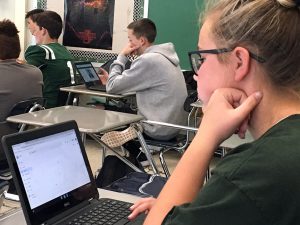 “There is no paper.”
“There is no paper.”
That is how Weedsport Jr.-Sr. High School teacher Tricia Austin describes her virtual classrooms of English language arts (ELA) 10 and college English.
Her virtual classrooms utilize a Chromebook and the Buzz learning management system. Chromebooks resemble traditional laptops, but instead of using a Windows operating system, they run on a system through Google Chrome. Her classes utilize the platform, Google Classroom, where she creates, distributes, and grades assignments.
“Students are not required to bring anything to class except the classroom textbook,” Austin said.
“With Buzz, all accounts are linked to each students’ Google drive where classroom materials and folders are virtually housed.”
Austin said all quizzes, assignments, discussion boards, videos and more are located on Buzz. The program allows students to take quizzes, receive an immediate grade and compare the score with the rest of the class. Students also have access to a rubric to see how his/her writing assignments are graded.
“If the kids have Wi-Fi, they can access all the material from anywhere. There’s also a calendar that shows what is due and when” Austin said. “The students can set it up so they get a text when something is due. They can even get an email if a grade drops below a certain point.”
Allison Weston took ELA 10 last year, and said the virtual classroom makes accessibility infinitely easier.
“If I missed a day of school or if I was sick for a few days, I didn’t have to really miss a thing,” she said.
Sophomore Isabella Petrus expressed similar sentiments.
“I think this makes school way more interesting. You also don’t have to worry about forgetting your homework or missing an assignment because it’s all right there on your computer,” she said.
Austin added that the technology has even changed instruction for the better.
“I can teach and explain things a lot more,” she said. “Students know what they have to do through Buzz.”


